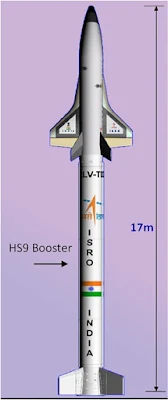What is RLV TD ?
RLV TD stands for Reusable Launch Vehicle – Technology Demonstration .
RLV is a series of technology demonstration missions that has been conceived by the Indian Space Research Organisation (ISRO) as a first step towards realising a Two Stage To Orbit (TSTO) re-usable launch vehicle.
The RLV TD is India’s first-ever indigenous made Reusable Launch Vehicle technology.
The Reusable Launch Vehicle can launch satellites into orbit around earth and then re-enter the atmosphere. It will also be able carry astronauts.
The RLV TD is the space analog of an aircraft.
Ideally it takes off vertically on the back of an expendable rocket and then glides back down like an aircraft. During landing phase, an RLV can either land on a runway or perform a splashdown. Small wings provide maneuverability support during landing.
ISRO successfully flight tested
ISRO believe that they could reduce the cost of launching stuff into space by as much as 10 times May 23, 2016 ISRO successfully flight tested India’s first winged body aerospace vehicle operating in hyper sonic flight regime.
In this experimental mission, the HS 9 solid rocket booster carrying RLV TD lifted off from the First Launch Pad at Satish Dhawan Space Centre, Sriharikota. After a successful flight of 91.1 second, HS 9 burn out occurred, following which both HS 9 and RLV-TD mounted on its top coasted to a height of about 56 km. At that height, RLV TD separated from HS 9 booster and further ascended to a height of about 65 km.
From that peak altitude of 65 km, RLV TD began its descent followed by atmospheric re-entry at around Mach 5 five times the speed of sound.
The vehicle’s Navigation, Guidance and Control system accurately steered the vehicle during this phase for safe descent.
After successfully surviving a high temperatures of re-entry with the help of its Thermal Protection System (TPS), RLV TD successfully glided down to the defined landing spot over Bay of Bengal, at a distance of about 450km from Sriharikota, thereby fulfilling its mission objectives.
The vehicle was successfully tracked during its flight from ground stations at Sriharikota and a shipborne terminal.
Total flight duration from launch to landing of this mission lasted for about 770 seconds A total of four RLV-TD flights are planned by ISRO.
HEX (Hyper-sonic Flight Experiment) completed on 23 May 2016.
LEX (Landing Experiment)
REX (Return Flight Experiment)
SPEX (Scram jet Propulsion Experiment) The RLV-TD is a part of a larger experiment this particular spacecraft is scaled down almost six times smaller than what the final version will be , which is around 40 meters that is equal to 12 Floors. It is described as "a very preliminary step" in the development of a reusable rocket, whose final version is expected to take 10-15 years and expect to launch in 2030.
Objectives of RLV TD :
- Hypersonic aero thermodynamic characterisation of wing body
- Evaluation of autonomous Navigation, Guidance and Control (NGC) schemes
- Integrated flight management
- Thermal Protection System Evaluation

No comments:
Post a Comment
Thanks